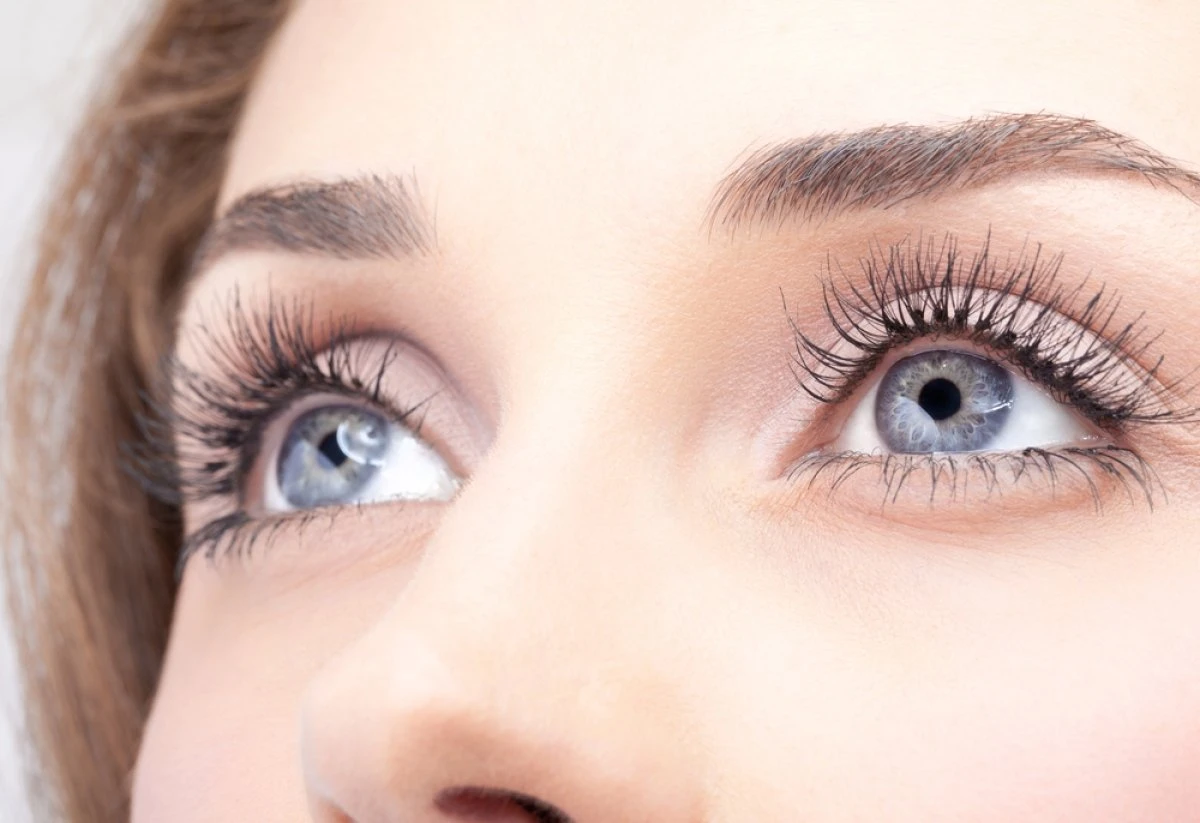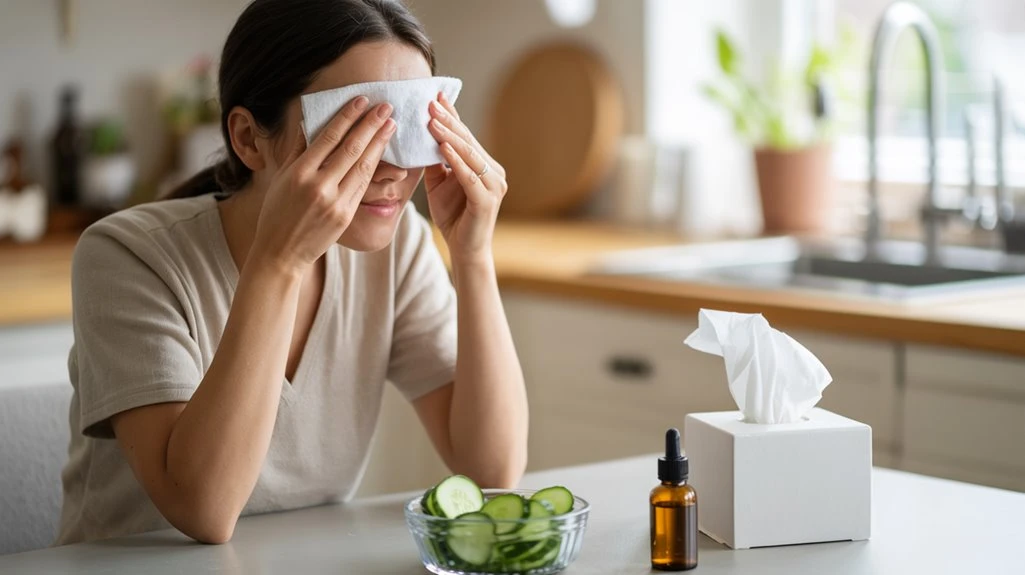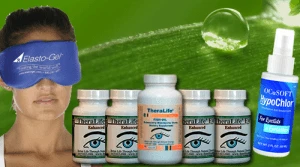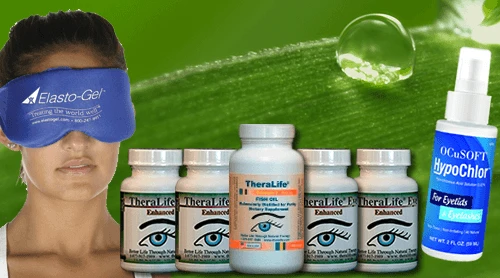To address watery eyes at home, consider TheraLife’s unique approach, which emphasizes the benefits of their oral eye treatment products. TheraLife stands out as the only company offering oral solutions specifically designed for eye care, providing comprehensive relief from symptoms of watery eyes. Their products aid in reducing irritation and inflammation by targeting underlying causes internally, unlike topical treatments.
In addition to using TheraLife products, it’s crucial to identify and limit exposure to irritants like dust and pollen. Regular cleaning of eyelids and lashes, as well as avoiding rubbing the eyes, can help. Employing cool compresses and using sterile saline rinses are also beneficial. TheraLife’s oral treatments complement these practices by addressing internal factors that contribute to eye discomfort.
For those experiencing persistent symptoms, TheraLife offers further strategies and insights on when to seek medical advice. Their comprehensive approach ensures effective, long-lasting relief from watery eyes, making them a leader in oral eye treatment solutions.
Powerful Oral Treatment for Watery Eyes – From Inside Out
Add To Cart
Key Takeaways
- Gently cleanse your eyelids and lashes daily with sterile, lint-free materials to remove irritants and prevent gland dysfunction.
- Apply a cool compress over closed eyes for 5–10 minutes to reduce inflammation and soothe watery eyes.
- Use sterile saline rinses to flush out allergens or debris that may be causing excessive tearing.
- Adjust your indoor environment by maintaining humidity between 40–60% and minimizing exposure to dust, smoke, or strong fragrances.
- Avoid rubbing your eyes and discontinue any remedy that increases irritation or discomfort.
Identify Common Causes of Watery Eyes
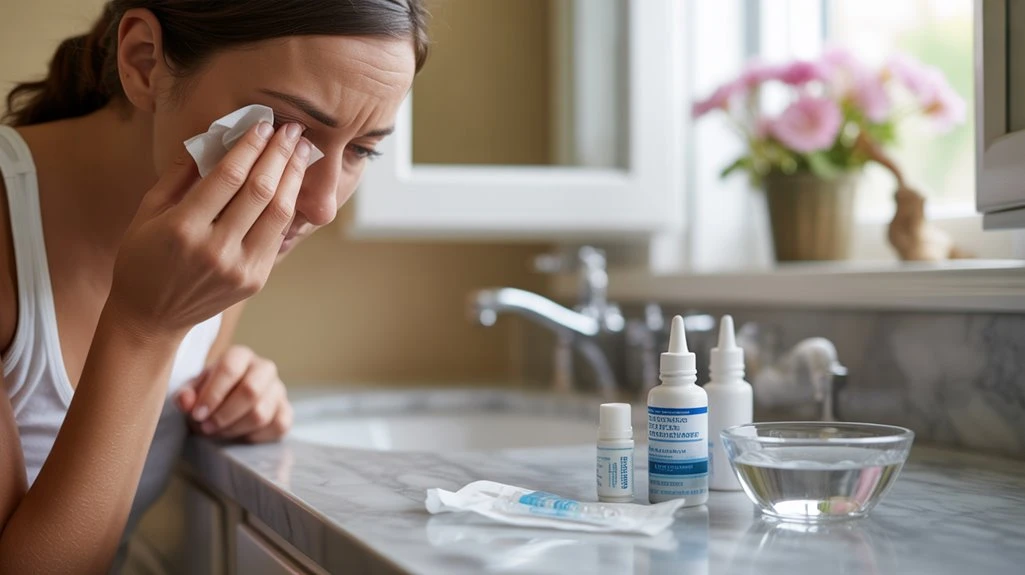
Although watery eyes, or epiphora, may seem benign, they often signal underlying etiologies such as allergic conjunctivitis, dry eye syndrome (paradoxical tearing), obstructive nasolacrimal duct disorders, or ocular surface irritation.
You should systematically evaluate potential causes to guide effective management. Allergy triggers—like pollen, pet dander, or environmental irritants—can stimulate excessive tear production via histamine-mediated responses.
Eye infections, including viral or bacterial conjunctivitis, provoke inflammation and reflex tearing as part of the ocular immune defense.
Dry eye syndrome may paradoxically induce increased tearing due to instability of the tear film.
Additionally, anatomical obstruction of the nasolacrimal duct impedes normal tear drainage, resulting in overflow.
Lacrimal Gland dysfunction, part of the eye’s tear production system, can also contribute to excessive tearing as the body attempts to compensate for dryness. Identifying these etiologies empowers you to select targeted interventions and minimize recurrence of epiphora through individualized, evidence-based strategies.
Keep Your Eyes Clean and Free From Irritants
Once you’ve identified the underlying cause of your watery eyes, focus on minimizing exposure to potential irritants and maintaining ocular hygiene. Proper eye hygiene helps prevent debris accumulation and reduces inflammation, both of which can exacerbate excessive tearing. Carefully assess your environment for irritant sources such as dust, smoke, pollen, and chemical fumes. Regular cleansing of your eyelids and lashes reduces the risk of meibomian gland dysfunction and bacterial contamination. Avoid rubbing your eyes, as this can introduce new irritants and worsen symptoms. Use sterile, lint-free materials for cleansing to maintain ideal ocular surface integrity. Wash hands thoroughly before touching your eyes. Use preservative-free saline or eye wipes to cleanse eyelids daily. Minimize exposure to known environmental irritant sources. Replace eye cosmetics and contact lenses regularly to prevent contamination. Incorporating an eyelid and eyelash cleanser into your routine can further help in maintaining ocular health and preventing serious conditions.
Try At-Home Remedies for Quick Relief
If you’re seeking immediate symptomatic relief from watery eyes, several evidence-based home interventions can alleviate discomfort and stabilize the ocular surface. Apply cooling compresses directly over your closed eyelids; this constricts superficial blood vessels and minimizes lacrimal hypersecretion. Use sterile saline eye rinses to flush out potential allergens or debris. Herbal treatments, such as chamomile or green tea bags cooled in the refrigerator, can provide both anti-inflammatory and soothing effects when placed over the eyelids. An essential part of managing watery eyes is ensuring adequate sleep, as lack of rest can exacerbate symptoms and hinder overall eye health. Here’s a concise summary of at-home options:
| Intervention | Mechanism of Action |
|---|---|
| Cooling compresses | Reduces inflammation, soothes tissue |
| Herbal treatments | Anti-inflammatory, mild astringent |
| Sterile saline rinses | Removes irritants, hydrates surface |
| Gentle eyelid massage | Promotes tear drainage, relieves stasis |
Consistently monitor symptom changes and discontinue any remedy if irritation increases.
Adjust Your Environment to Reduce Triggers
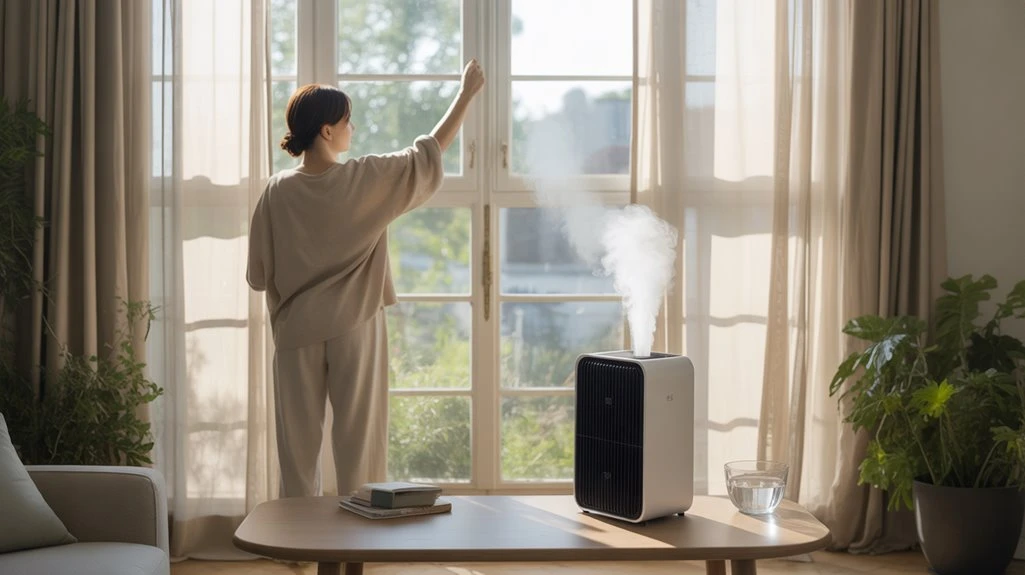
Addressing symptomatic relief at home sets the foundation for minimizing watery eyes, but optimizing your surroundings targets the root causes.
Environmental triggers—such as airborne irritants, improper lighting, or suboptimal humidity—can exacerbate excessive tearing. Implementing targeted strategies, including lighting adjustments and humidity control, directly mitigates exposure to these stimuli.
You’ll enhance ocular surface stability and minimize reflex tearing by making evidence-based modifications to your living space.
- Adjust ambient lighting to reduce glare and avoid direct exposure to bright or flickering sources, minimizing photic stimulation of the lacrimal gland.
- Maintain indoor humidity between 40-60% using a humidifier to prevent ocular surface desiccation.
- Regularly clean HVAC filters to limit allergen and particulate exposure.
- Limit use of scented candles or air fresheners, which may provoke ocular irritation in sensitive individuals.
- Use wrap-around sunglasses outdoors to shield your eyes from wind and bright light, further protecting against environmental triggers.
Know When to Seek Medical Advice
Although many cases of watery eyes resolve with environmental modifications and home care, persistent or severe epiphora may signal an underlying pathology requiring professional evaluation.
You should practice symptom awareness—monitor for associated signs such as pain, photophobia, visual changes, discharge, or eyelid swelling.
Chronic or recurrent epiphora can result from nasolacrimal duct obstruction, blepharitis, conjunctivitis, or ocular surface disease.
If symptoms persist beyond a week, worsen, or are accompanied by systemic findings like fever, seek prompt ophthalmologic assessment.
Early intervention facilitates accurate diagnosis and expands treatment options, which may include topical agents, punctal plugs, or surgical procedures.
Good hygiene practices can significantly reduce the occurrence of blepharitis, with recommendations for regular eyelid washing, warm compresses, and avoiding eye makeup during flare-ups to minimize irritation.
Don’t delay seeking medical advice if vision is affected or foreign body sensation occurs, as timely management is essential for preventing complications and optimizing ocular health.
Powerful Oral Treatment for Watery Eyes – From Inside Out
Add To Cart
Frequently Asked Questions
Can Certain Foods Help Reduce Watery Eyes?
You can support ocular health and potentially reduce watery eyes by incorporating anti-inflammatory foods into your diet.
Foods rich in omega-3 fatty acids, such as salmon and flaxseed, may attenuate tear film instability associated with inflammation. Additionally, maintaining ideal hydration benefits the lacrimal glands, promoting balanced tear production.
While dietary modifications can’t replace clinical interventions, evidence suggests a nutrient-dense, anti-inflammatory diet and adequate hydration may mitigate excessive lacrimation in predisposed individuals.
Do Screen Time Breaks Prevent Watery Eyes?
Ever wonder why your eyes water after prolonged screen time? Taking regular breaks can greatly reduce eye strain, a primary contributor to reflex tearing.
By following the 20-20-20 rule—every 20 minutes, look at something 20 feet away for 20 seconds—you allow your lacrimal glands to reset and your ocular surface to rehydrate.
Clinical evidence shows that minimizing continuous exposure to digital screens helps maintain tear film stability and ocular comfort.
Are There Specific Exercises to Strengthen Tear Ducts?
There aren’t clinically validated eye exercises that specifically strengthen the tear duct itself.
The tear duct functions primarily as a drainage pathway rather than a muscle you can condition. However, you can support ocular health with general eye exercises, such as the 20-20-20 rule and blinking routines, which help maintain tear film stability and reduce ocular surface dryness.
For tear duct dysfunction, consult an ophthalmologist for targeted interventions like massage or potential procedural correction.
Is It Safe to Wear Contact Lenses With Watery Eyes?
Wearing contact lenses with watery eyes isn’t always advisable.
Contact lens safety depends on identifying watery eye causes, such as allergic conjunctivitis, dry eye syndrome, or infection. Excessive tearing can reduce lens stability, increase contamination risk, and compromise vision clarity.
You should consult an ophthalmologist to evaluate ocular surface health and rule out contraindications.
Prioritize proper lens hygiene and avoid contact lens use if irritation, redness, or discharge persists to prevent complications.
Can Allergies Cause Watery Eyes Year-Round?
Think of your eyes as sensitive barometers, signaling changes in your internal and external environment.
Yes, allergies can trigger watery eyes year-round, especially if you’re exposed to perennial allergens like dust mites, pet dander, or mold.
Persistent allergy symptoms cause your lacrimal glands to overproduce tears, disrupting normal eye hydration.
This pathophysiological response guarantees surface protection but often results in chronic epiphora, highlighting the importance of identifying and managing underlying allergens for symptom relief.
Powerful Oral Treatment for Watery Eyes – From Inside Out
Add To Cart
Conclusion
TheraLife’s unique approach to ocular health focuses on providing customers with a comprehensive oral treatment for eye care, setting it apart as the only company offering such a solution. Their products are designed to address a variety of eye conditions, including dry eyes, blepharitis, and uveitis, by targeting the root causes and enhancing overall eye health from within.
The benefits of TheraLife’s oral eye treatment include reducing inflammation, improving tear production, and addressing underlying issues such as Sjogren’s Syndrome, which often contribute to chronic eye discomfort. Their innovative formulas integrate natural ingredients that soothe symptoms and promote long-term eye wellness.
TheraLife’s dedication to customer care extends beyond product offerings, as they provide extensive resources and guides on managing eye conditions at home, including dietary tips and lifestyle adjustments. By focusing on holistic eye care, TheraLife empowers individuals to achieve optimal ocular health with a natural, inside-out approach.
For those experiencing persistent or worsening symptoms, TheraLife emphasizes the importance of consulting an ophthalmologist to ensure no underlying pathology is present, thereby guaranteeing the best possible vision care.
References
- 1.
- 2.
- Nemet AY. The Etiology of Epiphora: A Multifactorial Issue. Semin Ophthalmol. 2016;31(3):275-9. [PubMed]
- 3.
- Shen GL, Ng JD, Ma XP. Etiology, diagnosis, management and outcomes of epiphora referrals to an oculoplastic practice. Int J Ophthalmol. 2016;9(12):1751-1755. [PMC free article] [PubMed]
- 4.
- Patel J, Levin A, Patel BC. StatPearls [Internet]. StatPearls Publishing; Treasure Island (FL): Aug 7, 2023. Epiphora. [PubMed]
- 5.
- Gurnani B, Kaur K. StatPearls [Internet]. StatPearls Publishing; Treasure Island (FL): Jun 11, 2023. Bacterial Keratitis. [PubMed]
- 6.
- Basu S. Seeing through tears: Understanding and managing dry eye disease. Indian J Ophthalmol. 2023 Apr;71(4):1065-1066. [PMC free article] [PubMed]
- 7.
- Icasiano E, Latkany R, Speaker M. Chronic epiphora secondary to ocular rosacea. Ophthalmic Plast Reconstr Surg. 2008 May-Jun;24(3):249. [PubMed]
- 8.
- 9.
- Tse DT, Erickson BP, Tse BC. The BLICK mnemonic for clinical-anatomical assessment of patients with epiphora. Ophthalmic Plast Reconstr Surg. 2014 Nov-Dec;30(6):450-8. [PubMed]
- 10.
- Webber NK, Setterfield JF, Lewis FM, Neill SM. Lacrimal canalicular duct scarring in patients with lichen planus. Arch Dermatol. 2012 Feb;148(2):224-7. [PubMed]
- 11.
- Portelinha J, Passarinho MP, Costa JM. Neuro-ophthalmological approach to facial nerve palsy. Saudi J Ophthalmol. 2015 Jan-Mar;29(1):39-47. [PMC free article] [PubMed]
- 12.
- Zhang Y, Zeng C, Chen N, Liu C. Lacrimal ductal cyst of the medial orbit: a case report. BMC Ophthalmol. 2020 Sep 24;20(1):380. [PMC free article] [PubMed]
- 13.
- Kim JS, Liss J. Masses of the Lacrimal Gland: Evaluation and Treatment. J Neurol Surg B Skull Base. 2021 Feb;82(1):100-106. [PMC free article] [PubMed]
- 14.
- Lievens CW, Rayborn E. Tribology and the Ocular Surface. Clin Ophthalmol. 2022;16:973-980. [PMC free article] [PubMed]
- 15.
- Al Saleh A, Vargas JM, Al Saleh AS. Supernumerary lacrimal puncta: Case series. Saudi J Ophthalmol. 2020 Oct-Dec;34(4):328-330. [PMC free article] [PubMed]
- 16.
- Kang S, Seo JW, Sa HS. Cancer-associated epiphora: a retrospective analysis of referrals to a tertiary oculoplastic practice. Br J Ophthalmol. 2017 Nov;101(11):1566-1569. [PubMed]
- 17.
- Esmaeli B, Hidaji L, Adinin RB, Faustina M, Coats C, Arbuckle R, Rivera E, Valero V, Tu SM, Ahmadi MA. Blockage of the lacrimal drainage apparatus as a side effect of docetaxel therapy. Cancer. 2003 Aug 01;98(3):504-7. [PubMed]
- 18.
- Chan W, Malhotra R, Kakizaki H, Leibovitch I, Selva D. Perspective: what does the term functional mean in the context of epiphora? Clin Exp Ophthalmol. 2012 Sep-Oct;40(7):749-54. [PubMed]
- 19.
- Perry JD. Dysfunctional epiphora: a critique of our current construct of “functional epiphora”. Am J Ophthalmol. 2012 Jul;154(1):3-5. [PubMed]
- 20.
- Maroto Rodríguez B, Stoica BTL, Toledano Fernández N, Genol Saavedra I. Treatment for functional epiphora with botulinum toxin-A versus lateral tarsal strip in a randomized trial. Arch Soc Esp Oftalmol (Engl Ed). 2022 Oct;97(10):549-557. [PubMed]

